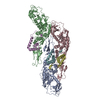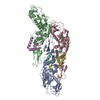+ Open data
Open data
- Basic information
Basic information
| Entry | Database: PDB / ID: 7esd | |||||||||
|---|---|---|---|---|---|---|---|---|---|---|
| Title | Mature Donggang virus | |||||||||
 Components Components | (Genome polyprotein) x 2 | |||||||||
 Keywords Keywords | VIRUS / flavivirus mature | |||||||||
| Function / homology |  Function and homology information Function and homology informationsymbiont-mediated suppression of host JAK-STAT cascade via inhibition of STAT2 activity / ribonucleoside triphosphate phosphatase activity / viral capsid / double-stranded RNA binding / methyltransferase cap1 activity / mRNA 5'-cap (guanine-N7-)-methyltransferase activity / RNA helicase activity / protein dimerization activity / symbiont-mediated suppression of host innate immune response / host cell endoplasmic reticulum membrane ...symbiont-mediated suppression of host JAK-STAT cascade via inhibition of STAT2 activity / ribonucleoside triphosphate phosphatase activity / viral capsid / double-stranded RNA binding / methyltransferase cap1 activity / mRNA 5'-cap (guanine-N7-)-methyltransferase activity / RNA helicase activity / protein dimerization activity / symbiont-mediated suppression of host innate immune response / host cell endoplasmic reticulum membrane / symbiont-mediated suppression of host type I interferon-mediated signaling pathway / serine-type endopeptidase activity / viral RNA genome replication / RNA-directed RNA polymerase activity / fusion of virus membrane with host endosome membrane / symbiont entry into host cell / virion attachment to host cell / host cell nucleus / virion membrane / structural molecule activity / proteolysis / extracellular region / ATP binding / metal ion binding / membrane Similarity search - Function | |||||||||
| Biological species |  Donggang virus Donggang virus | |||||||||
| Method | ELECTRON MICROSCOPY / single particle reconstruction / cryo EM / Resolution: 3.9 Å | |||||||||
 Authors Authors | Zhang, Y. / Liang, D. | |||||||||
| Funding support |  China, 1items China, 1items
| |||||||||
 Citation Citation |  Journal: Proc Natl Acad Sci U S A / Year: 2022 Journal: Proc Natl Acad Sci U S A / Year: 2022Title: Replication is the key barrier during the dual-host adaptation of mosquito-borne flaviviruses. Authors: Yanan Zhang / Dening Liang / Fei Yuan / Yiran Yan / Zuoshu Wang / Pan Liu / Qi Yu / Xing Zhang / Xiangxi Wang / Aihua Zheng /  Abstract: Mosquito-borne flaviviruses (MBFs) adapt to a dual-host transmission circle between mosquitoes and vertebrates. Dual-host affiliated insect-specific flaviviruses (dISFs), discovered from mosquitoes, ...Mosquito-borne flaviviruses (MBFs) adapt to a dual-host transmission circle between mosquitoes and vertebrates. Dual-host affiliated insect-specific flaviviruses (dISFs), discovered from mosquitoes, are phylogenetically similar to MBFs but do not infect vertebrates. Thus, dISF–MBF chimeras could be an ideal model to study the dual-host adaptation of MBFs. Using the pseudoinfectious reporter virus particle and reverse genetics systems, we found dISFs entered vertebrate cells as efficiently as the MBFs but failed to initiate replication. Exchange of the untranslational regions (UTRs) of Donggang virus (DONV), a dISF, with those from Zika virus (ZIKV) rescued DONV replication in vertebrate cells, and critical secondary RNA structures were further mapped. Essential UTR-binding host factors were screened for ZIKV replication in vertebrate cells, displaying different binding patterns. Therefore, our data demonstrate a post-entry cross-species transmission mechanism of MBFs, while UTR-host interaction is critical for dual-host adaptation. | |||||||||
| History |
|
- Structure visualization
Structure visualization
| Structure viewer | Molecule:  Molmil Molmil Jmol/JSmol Jmol/JSmol |
|---|
- Downloads & links
Downloads & links
- Download
Download
| PDBx/mmCIF format |  7esd.cif.gz 7esd.cif.gz | 293.9 KB | Display |  PDBx/mmCIF format PDBx/mmCIF format |
|---|---|---|---|---|
| PDB format |  pdb7esd.ent.gz pdb7esd.ent.gz | 239.6 KB | Display |  PDB format PDB format |
| PDBx/mmJSON format |  7esd.json.gz 7esd.json.gz | Tree view |  PDBx/mmJSON format PDBx/mmJSON format | |
| Others |  Other downloads Other downloads |
-Validation report
| Summary document |  7esd_validation.pdf.gz 7esd_validation.pdf.gz | 1 MB | Display |  wwPDB validaton report wwPDB validaton report |
|---|---|---|---|---|
| Full document |  7esd_full_validation.pdf.gz 7esd_full_validation.pdf.gz | 1.1 MB | Display | |
| Data in XML |  7esd_validation.xml.gz 7esd_validation.xml.gz | 54.1 KB | Display | |
| Data in CIF |  7esd_validation.cif.gz 7esd_validation.cif.gz | 78.9 KB | Display | |
| Arichive directory |  https://data.pdbj.org/pub/pdb/validation_reports/es/7esd https://data.pdbj.org/pub/pdb/validation_reports/es/7esd ftp://data.pdbj.org/pub/pdb/validation_reports/es/7esd ftp://data.pdbj.org/pub/pdb/validation_reports/es/7esd | HTTPS FTP |
-Related structure data
| Related structure data |  31288MC M: map data used to model this data C: citing same article ( |
|---|---|
| Similar structure data | Similarity search - Function & homology  F&H Search F&H Search |
- Links
Links
- Assembly
Assembly
| Deposited unit | 
|
|---|---|
| 1 | x 60
|
| 2 |
|
| 3 | x 5
|
| 4 | x 6
|
| 5 | 
|
| Symmetry | Point symmetry: (Schoenflies symbol: I (icosahedral)) |
- Components
Components
| #1: Protein | Mass: 54718.398 Da / Num. of mol.: 3 Source method: isolated from a genetically manipulated source Source: (gene. exp.)  Donggang virus / Production host: Donggang virus / Production host:  Aedes albopictus C6/36 cell densovirus / References: UniProt: H9BYJ9 Aedes albopictus C6/36 cell densovirus / References: UniProt: H9BYJ9#2: Protein | Mass: 8316.746 Da / Num. of mol.: 3 Source method: isolated from a genetically manipulated source Source: (gene. exp.)  Donggang virus / Production host: Donggang virus / Production host:  Aedes albopictus C6/36 cell densovirus / References: UniProt: H9BYJ9 Aedes albopictus C6/36 cell densovirus / References: UniProt: H9BYJ9Has protein modification | Y | |
|---|
-Experimental details
-Experiment
| Experiment | Method: ELECTRON MICROSCOPY |
|---|---|
| EM experiment | Aggregation state: PARTICLE / 3D reconstruction method: single particle reconstruction |
- Sample preparation
Sample preparation
| Component | Name: Donggang virus / Type: VIRUS / Entity ID: all / Source: NATURAL |
|---|---|
| Source (natural) | Organism:  Donggang virus Donggang virus |
| Source (recombinant) | Organism:  Aedes albopictus C6/36 cell densovirus Aedes albopictus C6/36 cell densovirus |
| Details of virus | Empty: NO / Enveloped: YES / Isolate: SPECIES / Type: VIRION |
| Buffer solution | pH: 7.4 |
| Specimen | Embedding applied: NO / Shadowing applied: NO / Staining applied: NO / Vitrification applied: YES |
| Vitrification | Cryogen name: ETHANE / Humidity: 100 % / Chamber temperature: 298 K |
- Electron microscopy imaging
Electron microscopy imaging
| Microscopy | Model: FEI TITAN |
|---|---|
| Electron gun | Electron source:  FIELD EMISSION GUN / Accelerating voltage: 300 kV / Illumination mode: FLOOD BEAM FIELD EMISSION GUN / Accelerating voltage: 300 kV / Illumination mode: FLOOD BEAM |
| Electron lens | Mode: DARK FIELD / Nominal defocus max: 2500 nm / Nominal defocus min: 1500 nm |
| Image recording | Electron dose: 35 e/Å2 / Film or detector model: GATAN K2 QUANTUM (4k x 4k) |
- Processing
Processing
| Software | Name: PHENIX / Version: 1.20.1_4487: / Classification: refinement | ||||||||||||||||||||||||
|---|---|---|---|---|---|---|---|---|---|---|---|---|---|---|---|---|---|---|---|---|---|---|---|---|---|
| CTF correction | Type: PHASE FLIPPING ONLY | ||||||||||||||||||||||||
| 3D reconstruction | Resolution: 3.9 Å / Resolution method: FSC 0.143 CUT-OFF / Num. of particles: 13490 / Symmetry type: POINT | ||||||||||||||||||||||||
| Refine LS restraints |
|
 Movie
Movie Controller
Controller




 PDBj
PDBj

